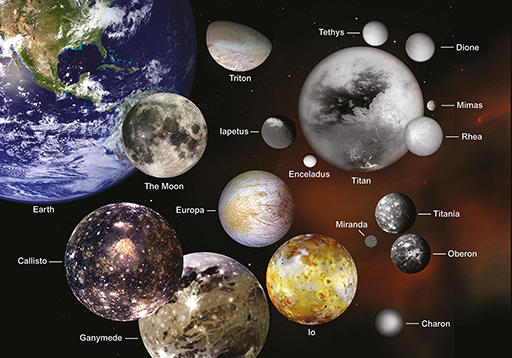1 Ice and rock – distance from the planet
The Solar System has at least 146 moons, not even counting the moons of asteroids, and they have a huge variety in size and composition (Figure 1). For many years, the composition of moons was a mystery and scientists are still unsure of many of the details.
The variety of formation mechanisms (that you learned about in Week 1) is one reason for the variety of compositions. A moon that has been captured (Triton, for example) is likely to differ from a moon that formed within an accretionary disc (such as Io). Our own Moon is uncommon in being mostly rocky with only the merest traces of water. There are only two large rocky moons in the Solar System: the Earth’s Moon and Io. The other moons have interiors with a varying ratio of ice : rock, and have surfaces that are made almost entirely of ice.
Ice is not necessarily pure frozen water. It can include specks of rocky or carbonaceous dust, various salts and the frozen forms of volatile substances, meaning substances that would tend to be gases if found on Earth. Example of such ‘volatiles’ include carbon monoxide, carbon dioxide, methane and ammonia. These too can occur in the form of ice, so be careful when you hear someone talking of ‘ice’ in the Solar System; they do not necessarily mean just frozen water. Generally, a moon’s composition is related to where in the Solar System it formed and how far it is from the primary planet.
The moons that formed within accretionary discs around planets show a grading of density and ice : rock ratio. This can be seen easily in the Galilean moons (the four large moons of Jupiter discovered by Galileo Galilei): the inner two (Io and Europa) are significantly denser than the outer two (Ganymede and Callisto). Rock is denser than ice, so this is evidence that the ice : rock ratio increases with distance from Jupiter. The accretionary disc around Jupiter would have been hotter and denser towards the centre, hindering the accretion of icy volatiles onto the inner moons.

